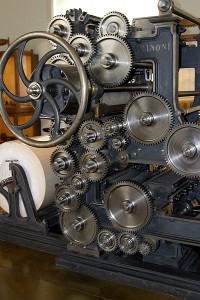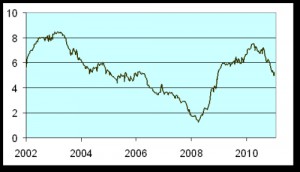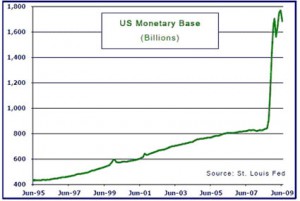Here is an excellent article by Bill Bonner on the announcement that Japan made that they are going to crank up the printing press and eliminate the deflation that has been plaguing their economy over the last twenty years. In it he explains the effects of money printing both short term and longer term. He also debunks the idea of where demand actually comes from. He says, "People always want stuff. Demand is infinite. Government doesn't have to stimulate it. What really matters is buying power."~Tim McMahon, editor Why Money Printing Makes You Poorer Last week, Japan announced that it would undertake a bold and radical experiment. After 23 years of on-again, off-again deflation, the new … [Read more...]
What Is Fiat Currency?
Fiat currency is a term that is used to describe a currency which is created by "fiat" or "arbitrary order or decree" of the government. It is not created by the free market or backed by anything like gold, silver or real estate. It is essentially an "IOU- nothing". A lot of people do not realize that every currency in the world today is considered to be a fiat currency. (Although the Chinese may be working on creating a gold backed currency and several OPEC countries have considered it as well). The US dollar, the euro, the Great Britain pound, the Japanese Yen, and the Australian dollar are all fiat currencies, to name a few. Since everyone uses this type of currency, why is it such a big … [Read more...]
The Fed Resumes Printing
By Bud Conrad, Casey Research The Federal Reserve recently announced important policy changes after its Federal Open Market Committee (FOMC) meeting. Here are the three most important takeaways, in its own words: The Committee decided today to keep the target range for the federal funds rate at 0 to 1/4 percent and currently anticipates that economic conditions – including low rates of resource utilization and a subdued outlook for inflation over the medium run – are likely to warrant exceptionally low levels for the federal funds rate at least through late 2014. The Committee judges that inflation at the rate of 2 percent, as measured by the annual change in the price index for … [Read more...]
Fed To ‘Hold Off’ On QE 3
We noted extreme levels of optimism earlier today. What could possibly trigger a correction in stocks and commodities? If the Fed fails to signal and/or announce another round of quantitative easing (QE), it would undoubtedly leave the markets disappointed. The Fed uses the Wall Street Journal (WSJ) as a medium to communicate with the markets. It is possible someone at the Fed picked up the phone and said, “We need to temper short-term expectations for another round of QE. Can you help us out?” Friday’s WSJ has an article titled “Fed Holds Off For Now on Bond Buys”. Notice the word “may” is not included. Here is the first paragraph of the article: Federal Reserve officials are waiting … [Read more...]
The Long Road to Inflation Perdition
Today David Galland interviews Terry Coxon. Terry has worked hand in hand with the legendary best selling author Harry Browne together they wrote Inflation-Proofing Your Investments published in 1981 . Terry also wrote Keep What You Earn and is an expert in monetary systems and first started writing about inflation during the last major inflationary period of the 1970's. David Galland is editor of The Casey Report. How the Federal Reserve is Locking Up Inflation David Galland: You were involved with Harry Browne during the last great inflation in the U.S. How does the increase in the money supply that kicked off in 2007-2008 compare in terms of scale to what went on leading up to the … [Read more...]
Does The “FED” Really Just Print Money?
Printing Money, Quantitative Easing, Money Supply and Currency in Circulation--- how do they relate? Today we are looking at an excellent explanation on the FED's money printing process by James Hamilton, economist of the University of California, San Diego. Did the Federal Reserve really print a Trillion dollars in their Quantitative Easing program? Did that increase the money supply by a Trillion dollars? He presents some interesting charts on currency in circulation versus currency reserves. Tim McMahon, editor … [Read more...]
Inflation and Velocity of Money
How do you define inflation? In some ways it's a slippery thing, like trying to nail Jell-O to a tree. One common definition amounts to "a general and sustained rise in the price of goods and services." Another is "a persistent decline in the purchasing power of money." Others argue that inflation is directly tied to the money supply. That is to say, they believe a substantial rise in the money supply is the same thing as inflation. (This is one small step removed from Milton Friedman’s old assertion: "Inflation is always and everywhere a monetary phenomenon.") Why is the debate important? Because of the infamous chart you see below (courtesy of hedge fund QB Partners and the St. Louis … [Read more...]
What is the Federal Reserve – Part 3
Money, Credit and the Federal Reserve Banking System Conquer the Crash, Chapter 10 By Robert Prechter How the Federal Reserve Has Encouraged the Growth of Credit Congress authorized the Fed not only to create money for the government but also to “smooth out” the economy by manipulating credit (which also happens to be a re-election tool for incumbents). Politics being what they are, this manipulation has been almost exclusively in the direction of making credit easy to obtain. The Fed used to make more credit available to the banking system by monetizing federal debt, that is, by creating money. Under the structure of our “fractional reserve” system, banks were authorized to employ … [Read more...]
What is the Federal Reserve – Part 2
This is Part II of our three-part series "Robert Prechter Explains The Fed." In part 1 we saw how Central Banks came into being and money went from something tangible and of value like Gold or Silver to paper backed by Gold to paper backed by nothing. You can read Part I in "What is the Federal Reserve - Part 1" -- and come back later this week for Part III. "Let's attempt to define what gives the dollar objective value. As we will see in the next section, the dollar is 'backed' primarily by government bonds, which are promises to pay dollars. So today, the dollar is a promise backed by a promise..." … [Read more...]
What is the Federal Reserve – Part 1
Do you really know What a Dollar is? Or how the FED controls interest rates? What is quantitative easing? Or (QE2)? Or monetary stimulus? For answers, let's turn to someone who has spent a considerable amount of time studying the Fed and its functions: EWI president Robert Prechter. Today we begin a 3-part series that we believe will help you understand the Fed as well as he does. (Excerpted from Prechter's Conquer the Crash and the free Club EWI report, "Understanding the Federal Reserve System.") Here is Part I. … [Read more...]




